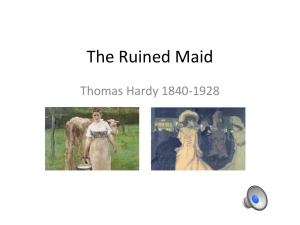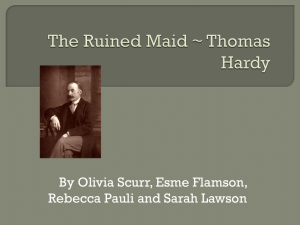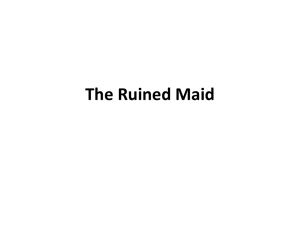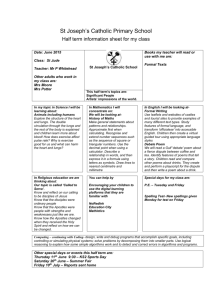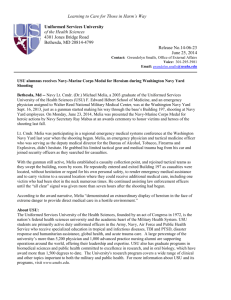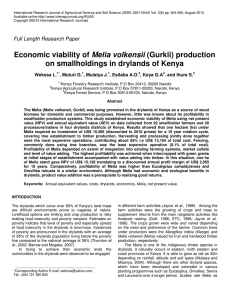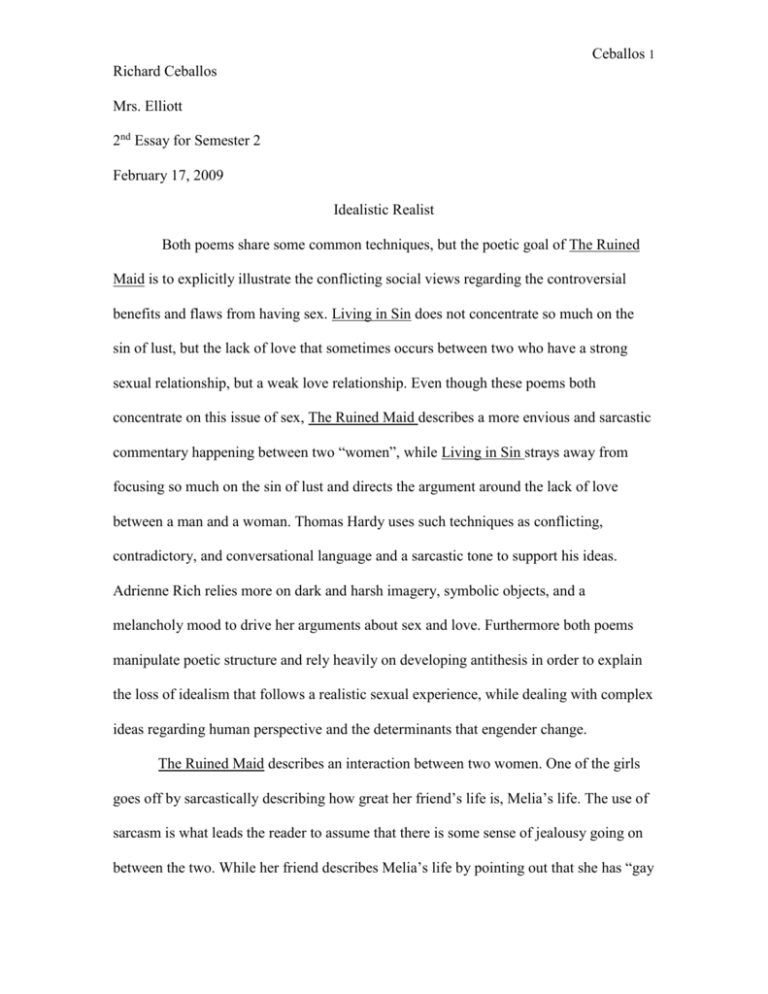
Ceballos 1
Richard Ceballos
Mrs. Elliott
2nd Essay for Semester 2
February 17, 2009
Idealistic Realist
Both poems share some common techniques, but the poetic goal of The Ruined
Maid is to explicitly illustrate the conflicting social views regarding the controversial
benefits and flaws from having sex. Living in Sin does not concentrate so much on the
sin of lust, but the lack of love that sometimes occurs between two who have a strong
sexual relationship, but a weak love relationship. Even though these poems both
concentrate on this issue of sex, The Ruined Maid describes a more envious and sarcastic
commentary happening between two “women”, while Living in Sin strays away from
focusing so much on the sin of lust and directs the argument around the lack of love
between a man and a woman. Thomas Hardy uses such techniques as conflicting,
contradictory, and conversational language and a sarcastic tone to support his ideas.
Adrienne Rich relies more on dark and harsh imagery, symbolic objects, and a
melancholy mood to drive her arguments about sex and love. Furthermore both poems
manipulate poetic structure and rely heavily on developing antithesis in order to explain
the loss of idealism that follows a realistic sexual experience, while dealing with complex
ideas regarding human perspective and the determinants that engender change.
The Ruined Maid describes an interaction between two women. One of the girls
goes off by sarcastically describing how great her friend’s life is, Melia’s life. The use of
sarcasm is what leads the reader to assume that there is some sense of jealousy going on
between the two. While her friend describes Melia’s life by pointing out that she has “gay
Ceballos 2
bracelets and bright feathers three!” Melia has to constantly remind her that she is ruined.
It is the last line at the end of each section of the poem, like “O didn’t you know I’d been
ruined?” and “some polish is gained with one’s ruin”, that illustrates the harsh reality of
loosing one’s virginity. Her friend’s envious attitude towards Melia’s situation greatly
contradicts the clear message Melia states. Melia does not want her friend to be jealous
because she wants her to see there is nothing to be jealous about especially when one is
ruined. The rhyming and playful structure of the poem greatly contradicts the dark and
conflicting nature of the relationship between these two women. Melia wants her friend
to see the ugly side of her life and the harsh reality of social acceptance, which is similar
to Living in Sin.
In Living in Sin, the focus on dramatic and dark settings really captures the
callous experience and realization after having a sexual experience. The “had thought”
part in the first section of the poem serves as a set-up for the speaker’s attitude and tone.
The woman of the poem thought that the apartment would take care of itself, but
throughout the poem the reader discovers the lack of realism present in the idealistic
lovers. The lovers watch their apartment fall apart, just like their relationship. The
metaphorical use of the apartment reflects the health of the lovers’ relationship. The
grotesque and grimy objects of the habitat, like the “sepulchral bottles”, “amusing
mouse”, and “last night’s cheese”, start to take over the lives of both characters. The out
of tune piano is symbolic of their failing relationship. The morning cold makes the
speaker realize the roughness and later impediments of life and love. At night the bleak
surroundings of the apartment go unnoticed, but yet the morning light that breaks through
the windows are a constant reminder of their contaminated life-style and filthy apartment.
Furthermore their foul life style says a lot about their lack of love and unwillingness to
Ceballos 3
deal with future responsibilities. Overall the focus of the poem is the sudden change in
perspective that the speaker experiences.
In comparison, both poems seem to draw on the attitudinal transformation
transpired by human sexual experiences, paralleling ideas revisited in Tess of the
D'urbervilles. In The Ruined Maid the virginal outlook of Melia’s friend builds heavy
contrast with Melia’s newfound hypercritical reaction to her friend’s misunderstanding.
Melia seems to take shameful pride in her metamorphic transformation. The use of
antithesis allows for the reader to fully comprehend the swift change in personal
viewpoints of the world. This is similar to Living in Sin and the author’s morbid tone.
Through the disturbing imagery the reader actually feels the speaker’s overwhelmed
reaction to realistic consequences. Furthermore the poems seem to relate to major ideas
mentioned in Tess of the D’urbervilles. All pieces put heavy emphasis on the loss of
idealism that consequently happens after a sexual encounter. In both poems manipulated
structure and poetic devices are used to illustrate the sudden flip, as the idealistic
neophytes of the world move toward becoming miserable and fearful pragmatics.

